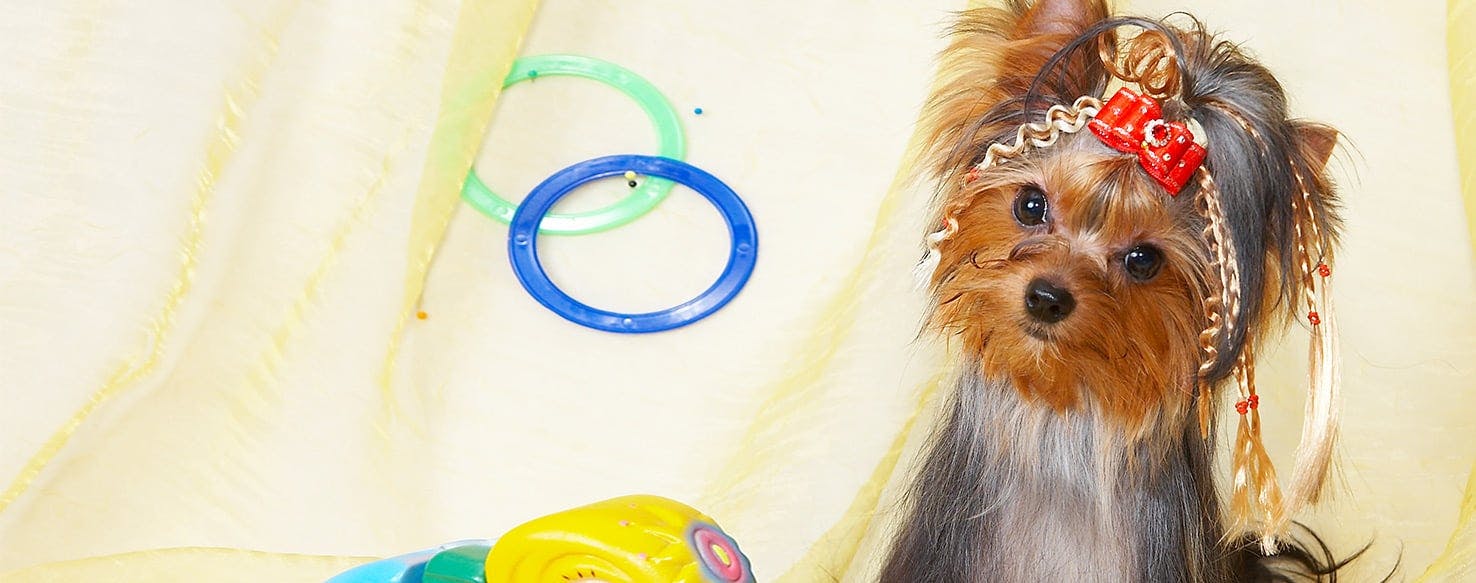- Home
- The Daily Wag!
- Senses
- Can Dogs Tell Colors Apart?

Have you ever wondered how your dog sees the world? Those big, puppy-dog eyes have got to see a lot. So fact or falsehood: are dogs colorblind?
Contrary to popular belief, dogs are in fact not colorblind! Although your pup isn't limited to black and white, dogs aren't able to see the same way us humans do.
So how does your pup truly see that dog park across from your house (or even your favorite shirt)? Read on to find out!
While science has now proven that dogs are limited to a spectrum of blues and yellows, there are some instances you may notice when your dog is looking at something in a color they can see.
For example, if you throw a green ball in your backyard, your pup may have a harder time finding that ball, but a blue or yellow ball would be easier to find. Or they may be able to tell the difference between a blue and red ball, but not a red and green one, as they view reds and greens the as the same.
Because dogs can distinguish between a few colors, it may be possible to train your pup to sort through those recognizable colors. Some have even been able to teach their pooches how to sort laundry!
Body Language
While you know that dogs can see some colors and not others, dogs may also exhibit body language signs that show what they can see. Here are some signs you may notice if your pup can see a particular color:<br/><br/>
- Staring
- Alert
- Head Tilting
- Wag Tail
Other Signs
Some other signs may include:
- Choosing Toys Or Balls In A Color They Can See
- Loosing A Red Ball In The Grass
Up until recently, it was a popular belief that dogs were colorblind. However, in 1989 researchers at the University of California in Santa Barbara decided to put this theory to the test. Their studies found that a dog's eyes are indeed color-sensitive, but only to an extent.
Researchers believe that limited color vision is likely due to the heritage of dogs and that the colors dogs are able to see are of biological importance. As descendants from wolves, dogs had to hunt to survive. Foraging for vibrantly colored fruits wasn't of value - so seeing colors like red or orange wasn't beneficial. However, being able to see through the camouflage of prey or to potentially identify a threat was a matter of life or death, and helps explain the colors available to them.
A professor of medical genetics at Cornell University's College of Veterinary Medicine has compared dogs' vision to red-green colorblindness in people. Colorblindness is extremely rare in humans, only existing in about 4% of the population, and usually occurs in males.
Humans are trichromatic. This means that our eyes contain three types of light-sensitive cones (blue, green, and red). Because humans are trichromatic, we are able to see all colors in the visible spectrum.
Most mammals, on the other hand, including dogs, are dichromatic. This means that their eyes only possess two types of light-sensitive cones. Because of this, dogs can see blue and yellow tones, but shades in the red-orange-green-range are difficult to see.
While humans have advantages because of the wide spectrum of colors they can see, when it comes to perceiving the finer detail in other environments, dogs win.
For instance, canines are able to see better in dim light. Their retinas possess more photoreceptors, in addition to having something called a tapetum lucidum. This reflects light through the retina twice—which we see when dogs' eyes are shining in the dark. Canines are also better than humans at picking up movement. So, if your pup appears to be tracking something at a distance, especially if you are in a dimly lit setting, you shouldn't ignore it.
Although you can't teach dogs to see more colors, it may be possible to teach dogs to tell apart the limited colors they can see.
Although a difficult task, some people have successfully taught their dogs to sort laundry! You can start by placing an article of clothing in each of several spots according to: whites, jeans, and colors. Place the piles far apart at first to minimize confusion. You can hand each piece of clothing from the basket stating the command that corresponds with the colored clothing. Then, point to the appropriate pile and walk with your pup to each pile. Make sure to reward your pup with a treat!
You can do this same sort of trick with your pup's toys and have your dog sort their toys or balls by color groups. Remember that this is a complicated trick, and will take time and patience to master.
Once you understand how your dog sees the world, you will be better at giving your pup exactly what is needed!
Have questions or concerns about your pet?
Chat with a veterinary professional in the Wag! app 24/7.
Get Vet ChatWritten by Olivia Gerth
Veterinary reviewed by:
Published: 03/04/2018, edited: 04/06/2020
More articles by Olivia Gerth

